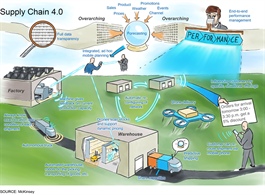Responding to the coronavirus fallout
Responding to the coronavirus fallout
The COVID-19 pandemic has created unprecedented uncertainty and significant operational challenges for many middle market businesses. As this situation continues to evolve, organisations should continuously re-evaluate and reassess their systems and processes for adapting to this new environment, mitigating risk and minimising negative impacts.

By Le Khanh Lam - Partner, RSM Vietnam
|
Here are some steps businesses can take in this new environment of partial social distancing measures and ongoing travel restrictions. Many of these considerations may also be helpful in continuity planning for other emergency scenarios.
Consistency is key
Consistent and routine messaging is reassuring for employees. At this point in the pandemic, organisations should regularly communicate with employees, even if the messaging contains little new information. Depending on the size and complexity of the organisation, this communication may occur at multiple levels, from all-hands bulletins to individual work teams, but the messaging should always be consistent and from the top down.
Regardless of the frequency or style, messaging content should briefly address how the company will continue to meet stakeholder expectations, how services will be delivered, and any operational changes needed to continue essential service delivery while protecting the health and safety of employees.
Key pieces of information businesses may want to address in these communications include updates on how leadership is actively monitoring events impacting the organisation; information about meetings to proactively adjust operations given pandemic data; effects on employees; reinforcement of remote work policies; and reminders to visit trusted health authorities’ websites.
Every organisation should also evaluate its external communications strategy to determine whether event-based messaging may be more appropriate than regular interval messaging, and whether to include a mechanism for refining communications based on feedback from clients, shareholders, and others.

Businesses in the entire country have been adapting new strategies to cope with challenges caused by the pandemic
|
Reassess the risks
Organisations should frequently reassess any operational adjustments that were made more than a week ago across key performance metrics. Companies should also re-examine their risk appetite and risk exposure against the performance of current critical functions or processes.
Lastly, businesses should identify any additional, short-term risk mitigation strategies that are possible to implement given the company’s current staffing matrix, resource levels, and inventories.
Organisations should review the initial identification and execution of essential services to determine if further business processes or functions should be suspended, or if the essential services should be expanded to meet demands. Businesses also need to consider potential changes in the current situation (for example rates of infection) and the impact those changes may have on the organisation’s ability to deliver essential services.
Leaders of essential services should frequently (at least daily) issue status reports that include information such as key performance indicators (or other metrics), liquidity levels, staffing levels, and process and technology updates.
Lastly, service, function and process suspension implies eventual resumption; therefore, organisations should begin to develop models for a phased resumption of suspended operations.
Staffing strategy alternatives
Continual monitoring of the staffing matrix implemented to deliver essential services is critical. The mix of primary and support staff should be monitored and reassessed in order to identify the impact of shelter-in-place restrictions on work and life; additional training and knowledge transfer measures required to improve staff availability and to meet current and future needs; successes and challenges of remote working; challenges in reassigning staff; and availability of mental and behavioral health services.
Organisations may also consider alternatives, such as external contracting services, to augment staffing plans and service or product demands. Alternatively, short-term outsourcing of specific business functions or processes may enable the organisation to offset certain demand needs and allow employees to maintain operations.
It is important to remember that while tens of millions of people are working remotely across North America, millions also continue to work at their job locations. Organisations should provide a mechanism for essential employees to provide feedback regarding the need for them to be on-site while their colleagues are working remotely.
Ultimately, all companies must continually reassess their protocols and procedures in order to provide a safe and healthy work environment for their employees.
Staying connected and secure
Businesses should reassess their policies for remote work and amend guidelines for flexible work schedules where possible, given the combination of modified working and personal environments. It is critically important for remote employees to feel connected to their colleagues and teams beyond electronic pathways, especially during the work day.
Organisations may consider designating staff to monitor or track successes, challenges and issues, and ideas to improve the remote working arrangements initially implemented. In addition, companies can consider identifying a mechanism (such as the crisis communication messages) to address provided feedback, which will serve to foster employee connectivity.
As a cautionary reminder, organisations should not relax information and data security practices during this time. Cybersecurity and data protection are more critical than ever with the dramatic increase in remote workers and the additional strain on technology infrastructure.
Increasing diversification
Vendor management and communication will continue to take on added importance as this situation continues to evolve. Best practices include:
- Developing a matrix of essential functions and processes with critical resources and their vendors so operations can be adjusted more efficiently;
- Forecasting resupply and the organisation’s demands more frequently;
- Communicating forecasted resupply needs to all leadership levels in order to maintain a common understanding of resource levels; and
- Communicating frequently with the most critical vendors regarding resupply needs, expectations and schedules.
Companies should also consider what new or different products and services they may need to respond to, in order to recover from this ongoing disruption this year. That evaluation should account for potential fluctuations in demand, modified operations and other possible future changes.
Finally, efforts should also continue to further diversify sourcing for key products and services. That might include preemptively evaluating and qualifying potential alternate vendors, negotiating contracts, and increasing and spreading order volumes so as to spread risk and mitigate vulnerabilities.



























